The hydraulic lifting light tower market is projected to reach 2.9 billion dollars in 2025 to USD 5.7 billion dollars in 2035, growing at a CAGR of 7.1%. During the early adoption phase from 2020 to 2024, demand was primarily driven by construction sites, mining operations, and event management companies testing equipment for mobility, efficiency, and safety. Entering the scaling phase in 2025, adoption expands as more commercial and industrial users integrate these towers into operations.
Manufacturers increase production capacity and strengthen distribution networks, while recurring demand from fleet operators contributes to steady revenue growth, supporting broader market penetration and adoption across multiple regions. From 2030 to 2035, the market is expected to reach 5.7 billion dollars, maintaining a CAGR of 7.1%. The consolidation phase sees leading manufacturers enhancing market share through strategic partnerships, expanded service offerings, and bulk contracts with industrial clients. Smaller players either specialize in niche applications or exit the market.
Adoption stabilizes as most potential users are engaged, prompting companies to focus on operational efficiency, cost optimization, and long-term service agreements. By 2035, the market exhibits mature competition, predictable growth, and standardized operational and safety protocols, forming a stable and well-structured industry environment.
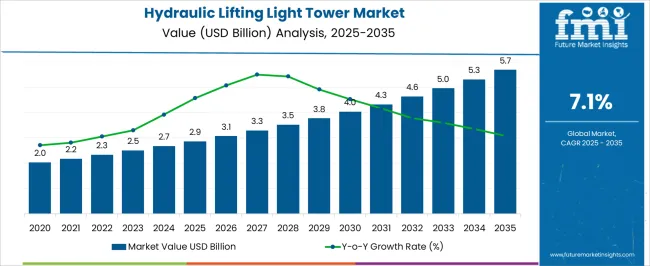
| Metric | Value |
|---|---|
| Hydraulic Lifting Light Tower Market Estimated Value in (2025 E) | USD 2.9 billion |
| Hydraulic Lifting Light Tower Market Forecast Value in (2035 F) | USD 5.7 billion |
| Forecast CAGR (2025 to 2035) | 7.1% |
The hydraulic lifting light tower market is driven by a variety of end-use segments. Construction & Infrastructure Projects dominate with approximately 35% of the market, where temporary lighting is essential for night-time operations and remote sites. Mining & Quarrying contributes 20%, using towers for safety and continuous operations in off-grid locations. Oil & Gas represents 12%, particularly for exploration and maintenance sites requiring portable illumination.
Events & Entertainment account for 10%, including outdoor concerts, festivals, and sports venues that rely on temporary lighting solutions. Transportation & Logistics contribute 8%, where night-time operations at ports, rail yards, and highways require reliable illumination. Emergency & Disaster Response holds 7%, providing rapid deployment for relief operations and temporary shelters. Telecom & Utility Maintenance represents 5%, supporting infrastructure inspections and repairs in remote areas.
Smaller segments, such as Agriculture and Military Operations, make up the remaining 3%, using specialized or small-scale towers. Revenue contributions mirror adoption trends, with construction and mining as primary drivers. Annual market value grows from 2.0 billion dollars in 2020 to 2.9 billion in 2025 and is projected to reach 5.7 billion by 2035, reflecting a CAGR of 7.1%. Event management, emergency response, and transport sectors show steady growth, expanding the market’s reach and application diversity.
The hydraulic lifting light tower market is experiencing notable growth driven by expanding infrastructure projects, increasing demand for efficient night-time operations, and the need for reliable mobile lighting in remote and industrial environments. Enhanced safety regulations and productivity requirements in construction, mining, and oil and gas sectors are accelerating adoption.
Hydraulic lifting mechanisms provide faster deployment, reduced manual effort, and improved operational stability, making them preferred over manual alternatives. Advancements in lighting technology, including higher lumen efficiency and longer operational lifespans, are further boosting market demand.
Additionally, rental service providers are expanding their fleets to cater to short-term and project-based requirements, creating steady revenue streams. The outlook remains positive as industries prioritize operational efficiency, worker safety, and adaptable lighting solutions for challenging environments.
The hydraulic lifting light tower market is segmented by channel, product, lighting, power source, application, and geographic regions. By channel, hydraulic lifting light tower market is divided into Sales and Rental. In terms of product, hydraulic lifting light tower market is classified into Stationary and Mobile. Based on lighting, hydraulic lifting light tower market is segmented into Metal Halide, LED, Electric, and Others.
By power source, hydraulic lifting light tower market is segmented into Diesel, Solar, Direct, and Others. By application, hydraulic lifting light tower market is segmented into Construction, Infrastructure Development, Oil & Gas, Mining, Military & Defense, Emergency & Disaster Relief, and Others. Regionally, the hydraulic lifting light tower industry is classified into North America, Latin America, Western Europe, Eastern Europe, Balkan & Baltic Countries, Russia & Belarus, Central Asia, East Asia, South Asia & Pacific, and the Middle East & Africa.
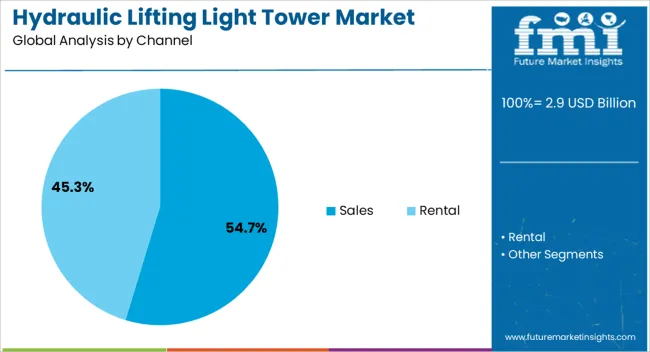
The sales channel segment is expected to account for 54.70% of the total market revenue by 2025, positioning it as the leading channel. This dominance is driven by growing preference among end users to own equipment for long-term use, reducing dependency on rentals.
Industries with continuous operational needs, such as large construction firms and mining companies, benefit from ownership through reduced downtime, customized maintenance schedules, and cost savings over extended periods.
The increasing availability of financing options and competitive pricing from manufacturers has further supported the growth of the sales channel.
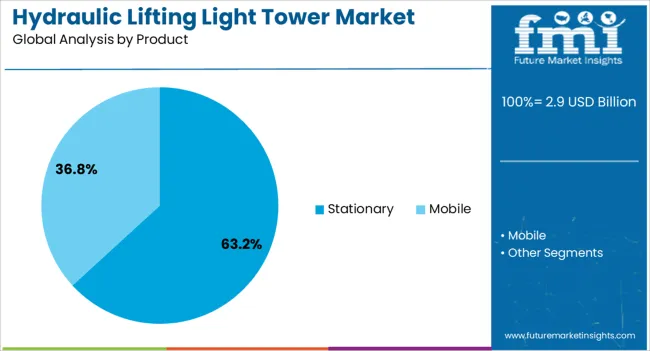
The stationary product segment is projected to hold 63.20% of market revenue by 2025, making it the largest product category. This growth is attributed to their durability, stability, and suitability for long-duration projects.
Stationary units are preferred in large-scale construction sites, mining operations, and infrastructure projects where consistent, high-intensity lighting is required for extended periods.
Their lower maintenance needs and robust design enable uninterrupted performance in harsh environments, making them a cost-effective and reliable choice for end users.

The metal halide lighting segment is anticipated to represent 41.60% of market revenue by 2025, leading the lighting category. This is due to its ability to deliver high-intensity illumination over wide areas, which is critical for safety and productivity in large outdoor worksites.
Metal halide lights offer excellent color rendering, aiding visibility and accuracy in operations. Their proven reliability and relatively lower upfront cost compared to some advanced lighting technologies make them a preferred choice in cost-sensitive projects.
The widespread familiarity with this lighting type and established supply chains further reinforce its market dominance.
The hydraulic lifting light tower market is growing due to increasing demand for high-mast, portable illumination in construction, mining, and emergency response. North America and Europe lead with advanced, automated, and high-lumen towers featuring hydraulic lifting systems for rapid deployment. Asia-Pacific shows rapid growth fueled by infrastructure projects, industrial operations, and outdoor events. Manufacturers differentiate through lighting intensity, lift height, energy efficiency, and mobility. Regional variations in application requirements, safety regulations, and operational environments strongly influence adoption, deployment efficiency, and competitive positioning globally.
Adoption of hydraulic lifting light towers is driven by the need for high-mast, portable illumination in construction sites, mining operations, and outdoor events. North America and Europe focus on towers with hydraulic systems that provide rapid mast extension, high lumen output, and precise positioning to improve operational efficiency and safety. Asia-Pacific markets emphasize cost-effective, versatile towers for large-scale infrastructure projects and remote locations. Differences in lifting capacity, mast height, and deployment speed affect operational coverage, worker safety, and project timelines. Leading suppliers offer towers with automated hydraulic controls, telescopic masts, and remote monitoring, while regional manufacturers provide durable, practical solutions. Deployment efficiency contrasts shape adoption, operational convenience, and competitiveness globally.
Energy-efficient and hybrid power options are critical drivers in the hydraulic lifting light tower market. North America and Europe prioritize towers with solar-assisted or battery-hybrid systems to reduce diesel consumption, emissions, and operational costs. Asia-Pacific markets adopt cost-effective fuel-based towers with gradual integration of hybrid solutions for extended runtime. Differences in energy efficiency, fuel consumption, and operational sustainability influence total cost of ownership, deployment strategy, and adoption. Leading suppliers provide hybrid or fully electric towers with optimized lighting and intelligent power management, while regional players focus on conventional, durable systems. Energy efficiency and power-source contrasts shape adoption, operational savings, and market competitiveness globally.
Safety and reliability are key factors driving hydraulic lifting light tower adoption. North America and Europe emphasize towers with overload protection, stabilized outriggers, anti-tip mechanisms, and automated shutdowns to protect personnel and equipment. Asia-Pacific markets focus on robust, user-friendly designs capable of operating in harsh environmental conditions. Differences in safety regulations, operational reliability, and maintenance practices affect purchase decisions, downtime, and long-term usability. Leading suppliers provide certified, high-reliability towers with automated diagnostics and hydraulic safeguards, while regional manufacturers deliver practical, low-maintenance solutions. Safety and reliability contrasts shape adoption, operational assurance, and market competitiveness globally.
Compliance with lighting, environmental, and hydraulic safety standards strongly affects market adoption. North America and Europe enforce strict regulations on illumination intensity, emissions, and mechanical safety, influencing tower design and certification. Asia-Pacific regulations vary; developed markets follow international standards, while emerging markets implement practical, locally recognized guidelines. Differences in compliance, application requirements, and versatility influence adoption, deployment, and customer trust. Leading suppliers provide certified, multi-purpose towers suitable for diverse applications, while regional manufacturers focus on affordable, regulation-aligned options. Regulatory and versatility contrasts shape adoption, market credibility, and competitive positioning globally.
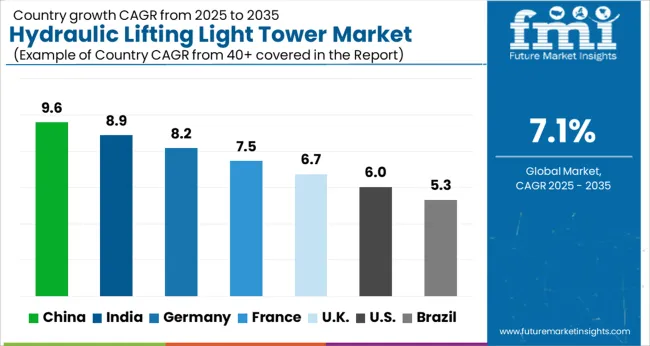
| Country | CAGR |
|---|---|
| China | 9.6% |
| India | 8.9% |
| Germany | 8.2% |
| France | 7.5% |
| UK | 6.7% |
| USA | 6.0% |
| Brazil | 5.3% |
The global wafer manufacturing equipment market was projected to grow at a 5.0% CAGR through 2035, driven by demand in semiconductor fabrication, microelectronics, and precision manufacturing applications. Among BRICS nations, China recorded 6.8% growth as large-scale production and assembly facilities were commissioned and compliance with industrial and safety standards was enforced, while India at 6.3% growth saw expansion of manufacturing units to meet rising regional demand. In the OECD region, Germany at 5.8% maintained substantial output under strict industrial and operational regulations, while the United Kingdom at 4.8% relied on moderate-scale operations for semiconductor and microfabrication applications. The USA, expanding at 4.3%, remained a mature market with steady demand across commercial and industrial microelectronics segments, supported by adherence to federal and state-level quality and safety standards. This report includes insights on 40+ countries; the top five markets are shown here for reference.
The hydraulic lifting light tower market in China is projected to grow at a CAGR of 9.6% due to rising infrastructure projects and construction activities requiring reliable lighting solutions. Adoption is being driven by light towers that provide adjustable height, mobility, and energy efficient illumination for construction sites and outdoor events. Manufacturers are being encouraged to supply durable, high quality, and technologically advanced equipment. Distribution through industrial equipment suppliers, rental services, and construction contractors is being strengthened. Research into improved hydraulic mechanisms, energy efficiency, and LED lighting technology is being conducted. Increasing construction activity, urban development projects, and demand for portable lighting solutions are considered key factors supporting the hydraulic lifting light tower market in China.
The hydraulic lifting light tower market in India is expected to grow at a CAGR of 8.9%, driven by expansion of construction, mining, and industrial operations requiring temporary lighting solutions. Adoption is being strengthened by light towers that provide portability, adjustable height, and reliable illumination for varied environments. Manufacturers are being encouraged to deliver cost effective, safe, and efficient equipment. Distribution through rental companies, construction firms, and industrial suppliers is being expanded. Technical demonstrations and training programs are being conducted to ensure proper usage and maintenance. Increasing infrastructure projects, industrial growth, and demand for flexible lighting solutions are recognized as primary drivers of the hydraulic lifting light tower market in India.
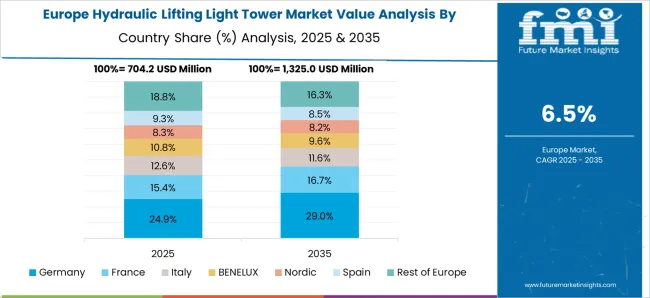
Germany is witnessing growth in the hydraulic lifting light tower market at a CAGR of 8.2%, supported by adoption in construction, mining, and outdoor event sectors. Adoption is being strengthened by light towers that offer adjustable hydraulic height, energy efficient illumination, and mobility. Manufacturers are being encouraged to supply technologically advanced, safe, and durable equipment. Distribution through construction contractors, industrial suppliers, and rental companies is being maintained. Research in energy efficient LED technology, improved hydraulic systems, and ergonomic designs is being conducted. Infrastructure development, industrial projects, and regulatory emphasis on energy efficiency are considered key contributors to the growth of the hydraulic lifting light tower market in Germany.
The hydraulic lifting light tower market in the United Kingdom is expected to grow at a CAGR of 6.7% due to increasing demand for portable lighting in construction sites, outdoor events, and industrial operations. Adoption is being emphasized for equipment that provides adjustable height, mobility, and reliable illumination. Manufacturers are being encouraged to deliver high quality, safe, and efficient light towers. Distribution through rental services, industrial suppliers, and construction firms is being strengthened. Demonstrations and awareness programs are being conducted to ensure proper usage and maintenance. Expansion of infrastructure projects, industrial activities, and event lighting requirements are recognized as primary factors supporting growth of the hydraulic lifting light tower market in the United Kingdom.
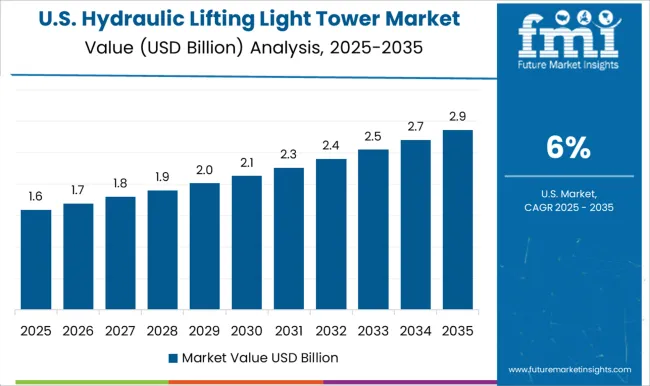
The hydraulic lifting light tower market in the United States is projected to grow at a CAGR of 6.0%, driven by increasing construction, industrial, and emergency response requirements for portable lighting. Adoption is being supported by light towers that offer mobility, adjustable height, and energy efficient illumination. Manufacturers are being encouraged to supply durable, reliable, and technologically advanced equipment. Distribution through rental companies, construction firms, and industrial suppliers is being maintained. Research in LED efficiency, hydraulic mechanism optimization, and safety improvements is being conducted. Growth in infrastructure development, industrial operations, and emergency preparedness are considered key drivers of the hydraulic lifting light tower market in the United States.
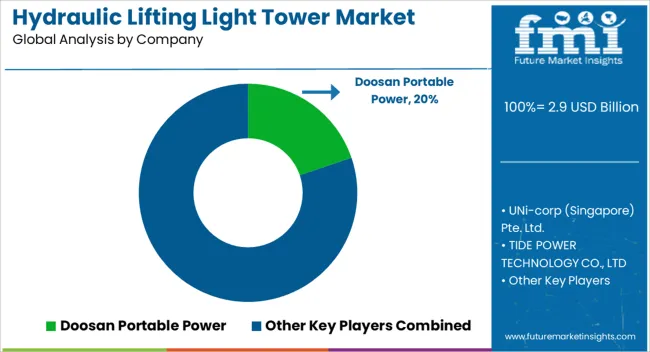
The hydraulic lifting light tower market is shaped by a combination of global equipment manufacturers, regional suppliers, and specialized construction and industrial lighting solution providers. Leading players such as Generac Holdings, Atlas Copco, Terex Corporation, and Doosan Portable Power hold strong positions by offering diversified portfolios of hydraulic lift light towers, including diesel and electric-powered models suitable for construction sites, mining operations, and outdoor events. Competitive differentiation is largely driven by mast height, lighting intensity, fuel efficiency, portability, and ease of operation. Regional manufacturers, particularly in Asia-Pacific and Europe, compete by providing cost-effective solutions and localized after-sales service for industrial and temporary lighting applications.
Strategic partnerships with rental service providers, construction contractors, and event management companies enhance market reach and brand visibility. Innovation in LED lighting, remote monitoring, automated mast control, and low-maintenance hydraulic systems further strengthens competitive positioning. Companies prioritizing technological advancement, compliance with safety standards, and robust service networks are well-positioned to capture significant shares in the growing hydraulic lifting light tower market, driven by rising infrastructure development and increasing demand for reliable, high-performance portable lighting solutions.
| Item | Value |
|---|---|
| Quantitative Units | USD 2.9 Billion |
| Channel | Sales and Rental |
| Product | Stationary and Mobile |
| Lighting | Metal Halide, LED, Electric, and Others |
| Power Source | Diesel, Solar, Direct, and Others |
| Application | Construction, Infrastructure Development, Oil & Gas, Mining, Military & Defense, Emergency & Disaster Relief, and Others |
| Regions Covered | North America, Europe, Asia-Pacific, Latin America, Middle East & Africa |
| Country Covered | United States, Canada, Germany, France, United Kingdom, China, Japan, India, Brazil, South Africa |
| Key Companies Profiled | Doosan Portable Power, UNi-corp (Singapore) Pte. Ltd., TIDE POWER TECHNOLOGY CO., LTD, Larson Electronics, GENMAC S.r.l.s.u., Standard Aggregatebau Evers GmbH & Co. KG, Atlas Copco, WANCO INC., Robuster Lighting, Sunbelt Rentals, Inc., Coates, HIMOINSA, Allmand Bros., Midstream Ltd., MPMC Powertech Corp., GREEN POWER SYSTEMS s.r.l., Superwatt Power, Wacker Neuson Group, Sinopro, and J C Bamford Excavators Ltd. |
| Additional Attributes | Dollar sales vary by product type, including diesel-powered, solar-diesel hybrid, and fully electric light towers; by application, such as construction sites, mining operations, emergency response, and outdoor events; by end-use, spanning construction companies, mining firms, government agencies, and event organizers; by region, led by North America, Europe, and Asia-Pacific. Growth is driven by rising demand for portable, high-intensity lighting and off-grid operational needs. |
The global hydraulic lifting light tower market is estimated to be valued at USD 2.9 billion in 2025.
The market size for the hydraulic lifting light tower market is projected to reach USD 5.7 billion by 2035.
The hydraulic lifting light tower market is expected to grow at a 7.1% CAGR between 2025 and 2035.
The key product types in hydraulic lifting light tower market are sales and rental.
In terms of product, stationary segment to command 63.2% share in the hydraulic lifting light tower market in 2025.






Full Research Suite comprises of:
Market outlook & trends analysis
Interviews & case studies
Strategic recommendations
Vendor profiles & capabilities analysis
5-year forecasts
8 regions and 60+ country-level data splits
Market segment data splits
12 months of continuous data updates
DELIVERED AS:
PDF EXCEL ONLINE
Hydraulic Lifting Mobile Light Tower Market Size and Share Forecast Outlook 2025 to 2035
Hydraulic Anchor Drilling Vehicle for Mining Market Size and Share Forecast Outlook 2025 to 2035
Hydraulic Gear Pumps Market Size and Share Forecast Outlook 2025 to 2035
Hydraulic Recloser Market Size and Share Forecast Outlook 2025 to 2035
Hydraulic Fracturing Market Size and Share Forecast Outlook 2025 to 2035
Hydraulic Power Unit Market Size and Share Forecast Outlook 2025 to 2035
Hydraulic Squeeze Chute Market Size and Share Forecast Outlook 2025 to 2035
Hydraulic Cylinder Market Size and Share Forecast Outlook 2025 to 2035
Hydraulic Filters Market Size and Share Forecast Outlook 2025 to 2035
Hydraulic Dosing Pump Market Size and Share Forecast Outlook 2025 to 2035
Hydraulic Fluids Market Analysis - Size, Share, and Forecast 2025 to 2035
Hydraulic Fluids & Process Oil Market Size 2025 to 2035
Hydraulic Pumps Market Growth & Outlook 2025 to 2035
Hydraulic Intensifiers Market Growth – Trends & Forecast 2025 to 2035
Hydraulic Spreader Market
Hydraulic Demolition Machine And Breaker Market
Hydraulic Cab Tilt System Market
TBR Hydraulic Curing Press Market Size and Share Forecast Outlook 2025 to 2035
Electrohydraulic Pump Market Insights by Type, End Use, Application, and Region through 2035
Railway Hydraulic Damper Market

Thank you!
You will receive an email from our Business Development Manager. Please be sure to check your SPAM/JUNK folder too.
Chat With
MaRIA